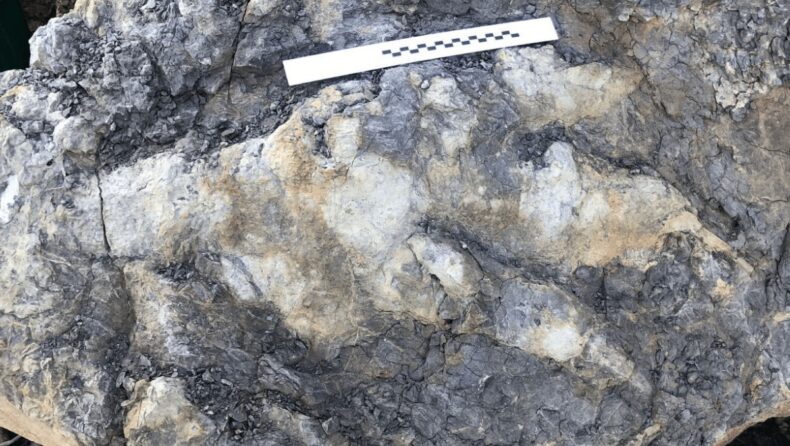- The fossil had been discovered by Marie Woods, an archaeologist, when she was looking for shellfish for dinner
A one-meter-long footprint left by a vast, carnivorous theropod dinosaur from the Jurassic period was discovered in Yorkshire, UK. Interestingly, the strange footprint was made when the dinosaur was resting or hunching over, about 166 million years ago.
The Yorkshire Coast
A large number of dinosaur footprints, as well as visually and scientifically remarkable fossils, have been found all around the Yorkshire coastal area. Paleontologists and fossil lovers frequently visit the site to search for the same. However, it is an exceptional sighting of a three-toed (tridactyl) footprint around 80 centimeters in length.
The discovery of the footprint
In April 2021, Marie Woods, a local archaeologist, first saw the footprint. She unintentionally discovered a magnificent fossil while roaming around the Yorkshire coast to search for shellfish for her dinner. Ms. Woods connected with local fossil experts in her excitement to confirm that the footprint was already documented, but people were still unaware of the meaning of what she was describing. Later, she contacted Dr. Dean Lomax, a renowned paleontologist affiliated with the University of Manchester and the writer of “Dinosaurs of the British Isles.”
Marie, a research co-author, commented, “I couldn’t believe what I was looking for.” I already saw smaller footprints while roaming with friends, but this is somewhat different. I can no longer say that ‘archaeologists don’t do dinosaurs.’ The discovery generated huge public interest, and I was stunned by the messages on social media platforms from people around the globe.

A rare Fossil sighting
Only six other footprints from similar families have been found in the Yorkshire area. The first one was discovered in 1934. The recent discovery of footprints along the Yorkshire Coast is scientifically significant. The three-toed tridactyl print is the biggest one ever discovered. The article on the present findings was published in the Proceedings of the Yorkshire Geological Society. The primary author, John Hudson, discussed the earlier fossil demonstrated in the Rotunda Museum, Scarborough, in 2006.
Professional fossil hunters and the main researcher (John Hudson) commented that the significant finding helps provide more information that this region was initially inhabited by meat-eating dinosaurs and belongs to the Jurassic era. The typical footprint and age show that the dinosaur resembles the Megalosaurus kind of dinosaur, with a probable hip height of 2.5 to 3 meters. Megalosaurus became the first dinosaur to receive a formal description in 1824.

After examining photos shared by researchers, the research team concluded that the specimen was extremely fragile and would not be able to sustain more damage if left unprotected in the coastal area. Immediately, the fossil was saved by experts Mark, Aaron, and Shae Smith of Redcar.
The fossil was initially seen five months earlier by Rob Taylor, a local fossil hunter and co-author of the research. However, the significance of the footprint was only partially appreciated at the time of the initial discovery since the footprint needed to be completely visible.
Marie and Rob kindly donated the fossil to the Scarborough Museum and Galleries. John Hudson and Dr. Dean Lomax, with guidance from Dr. Mike Romano from the University of Sheffield, have studied the fossil. For more than 20 years, Dr. Romano has collected and examined hundreds of dinosaur footprints along the Yorkshire coastal area of the UK. The team has also compared the new fossil with others found worldwide, particularly in Europe and North America.













